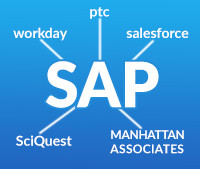- March 2, 2017
- Len Riley
- Reading Time: 5 minutes

For many SAP customers, SAP’s claims in the Diageo case are familiar. SAP has positioned indirect use claims via audits, conducted by SAP’s Strategic Initiatives Group, as a sales lever for many years. SAP customer executives and their legal teams have been waiting for the day when “someone would take on SAP publicly.”
That day has come. And the result, right or wrong, has left company executives responsible for managing their SAP relationships with the task of accessing SAP’s and Diageo’s claims, the UK High Court’s findings and the potential financial risk to their company.
The following provides UpperEdge’s assessment of the material points and concerns from the Diageo case based on our review of the UK High Court findings and our experience assisting SAP customers in the negotiation of SAP license and cloud agreements inclusive of defending and negotiating complex compliance matters involving use of the SAP software by way of indirect access. As a point of reference, we have advised on well over 400 SAP negotiations so the range of scenarios and use cases is extremely broad and deep.
SAP Won the Contractual Argument
For years, SAP’s contractual position on the use of its software by way of Indirect Access has been relatively consistent. Executives who have previously looked to their legal teams for guidance on the issue now have another data point to gauge their risk.
Although individual SAP customer agreements vary and should be individually assessed, the court agreed with SAP on its claim of indirect use, concluding the following:
- Only Named Users are authorized to use or access the SAP software directly or indirectly.
- Named User pricing is the only basis on which the SAP software was and is licensed.
- Engine product fees (in this case PI) do not remove the requirement to license Named Users.
The court rejected Diageo’s argument that SAP PI is a “gatekeeper” license intended for the Salesforce.com platform to gain access to the SAP ERP suite and therefore Diageo should not be subject to additional Named User license and maintenance fees for its users of the Salesforce.com platform.
The court also rejected Diageo’s argument that the agreement did not explicitly state that users of third-party software interfacing with the SAP software are required to be Named Users and therefore not subject to additional fees.
Customer Use & Data is on the Table
In our experience, SAP has primarily focused its compliance claims of use by way of indirect access on business scenarios involving internal users and business partners accessing the SAP software through a third party application. In this case, SAP expanded its position arguing that Diageo’s customers should be considered Named Users as well given they were indirectly accessing the SAP software.
The court agreed with SAP and found the following interactions between SAP ERP and Diageo’s Connect system which was built on the Salesforce.com platform to constitute use as a result of indirect access by Diageo’s Customers.
By way of example, the Court referenced the following interactions to support its findings:
- Customer master data and product master data in SAP ERP is required to enable a customer to create an order through Connect.
- Sales area logistics rules in SAP ERP are required to enable a customer to create an order through Connect.
- Customers can view historical sales and accounting data.
The court rejected Diageo’s argument that the use case scenario was similar to how Diageo was previously entering customer orders through call center agents and customers would not be required to be named users under that scenario. The court ruled it was different in the Connect scenario because Diego’s customers were indirectly accessing the SAP ERP system via Connect and therefore those customers should be considered a Named User, just like the prior call center agents were considered named users.
An Opportunity to Hold SAP Accountable Missed
Since the introduction of the indirect access concept by SAP, customers have been in search of clarity with respect to definitive contractual language and pricing. Unfortunately, many SAP customers have not invested enough in the subject matter expertise, process and tools required to remain compliant. This, coupled with SAP’s reluctance to set clear expectations and clear criteria for indirect use and then subsequently using that same ambiguity to blindside customers has eroded customer trust.
In the Diageo SAP case, the court invested significant effort in interpreting Diageo’s commercial agreement with SAP, specifically Named User-based pricing, concluding the agreement did not contain an appropriate user type related to customer use. The court appeared to be sympathetic to SAP indicating that “in 2004, the effective date of the agreement, such usage through cloud-based portals was not generally available and therefore unsurprisingly, it is not explicitly called out in the schedule.”
Unfortunately, at least at this point in the trail, the court did not compel SAP to present its current pricing and business practices related to indirect access.
SAP Has Clearly Gone All In… Why?
Look no further than SAP’s Full Year 2016 Preliminary Results Release on January 24, 2017. SAP’s presentation includes a view of the SAP Digital Business Framework. You will notice the SAP view of the Digital Core is S/4HANA supporting Business Transactions and Intelligent Insights.
On the periphery, the Digital Core supports the Customer Experience, Workforce Engagement, IoT & Supply Chain and Spend Management. Within the framework, SAP also positions its complementary cloud solutions, such as Ariba, Concur, Fieldglass, Hybris, Leonardo and SuccessFactors.
The bottom line… SAP has gone all in on the Diageo case and has been all in on this concept for years because SAP’s future revenue and share of the cloud market is on the line. SAP has clearly developed and is executing on its strategy to incent adoption of SAP cloud solutions. SAP has also positioned itself to capture incremental revenue even if a customer elects to choose an alternative best-of-breed solution.
Our experience shows that company executives are most comfortable navigating their SAP relationship when they fully understand the following:
- How strong and of what quality is my SAP relationship?
- What is the overall quality of my commercial agreement with SAP?
- What is my true utilization of the SAP software given what I bought and deployed and what optimization opportunities exist?
- What is my overall compliance risk, inclusive of direct and indirect use?
- Given my future demand profile with SAP, what should my next-generation relationship look like with SAP?
In summary, the issue of use by way of indirect access is not going away. SAP firmly believes it has the right to protect its intellectual property and believes it should to protect the value of its software. SAP customers are well advised to proactively assess their SAP relationship in a holistic manner as outlined in the 5 points above. We look forward to sharing these strategies and results SAP customers have achieved with you soon in an upcoming webinar. In the meantime, do not hesitate to contact us if you would like UpperEdge to conduct a deep dive assessment or health check on your SAP relationship. If you are interested in conducting a high-level assessment of your organization’s SAP Indirect Access exposure, please refer to our SAP Indirect Access Tool. As always, we welcome your feedback and questions.
Follow me on Twitter @lpriley6, find my other UpperEdge blogs, and follow UpperEdge on Twitter and LinkedIn
